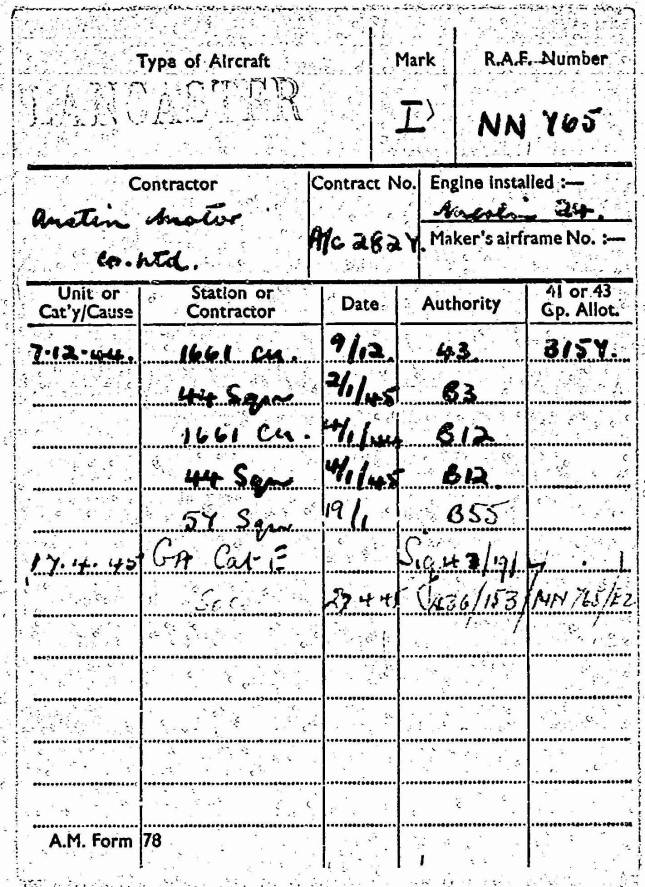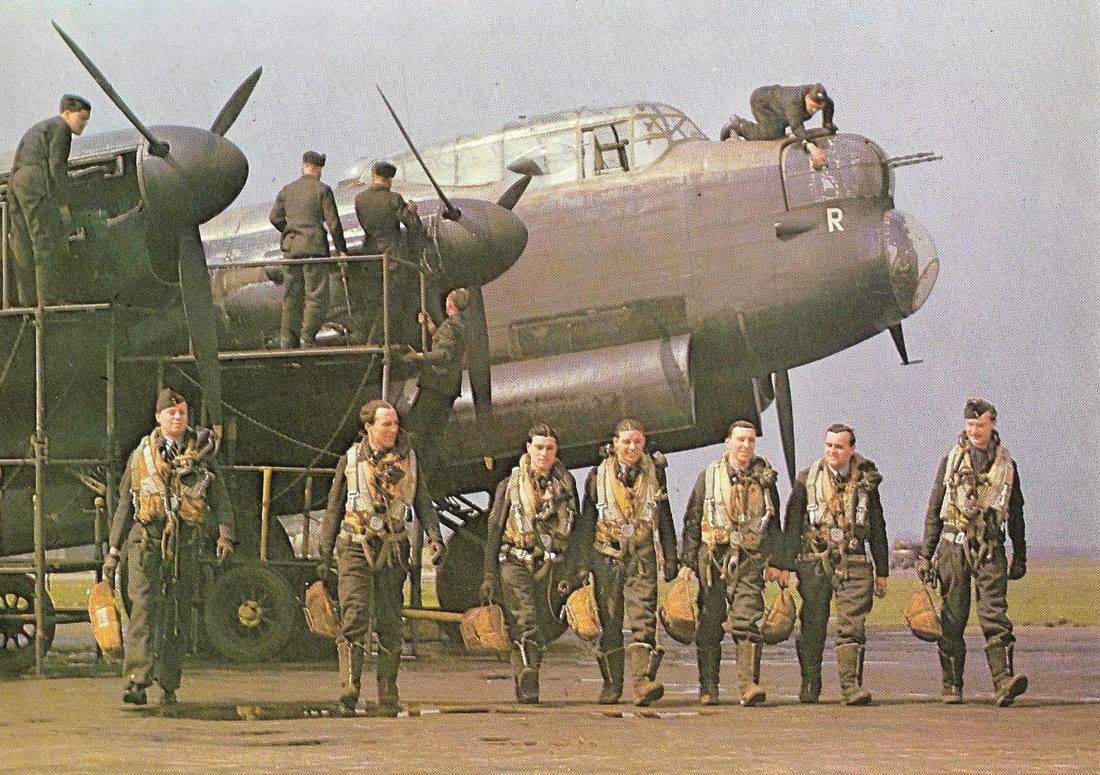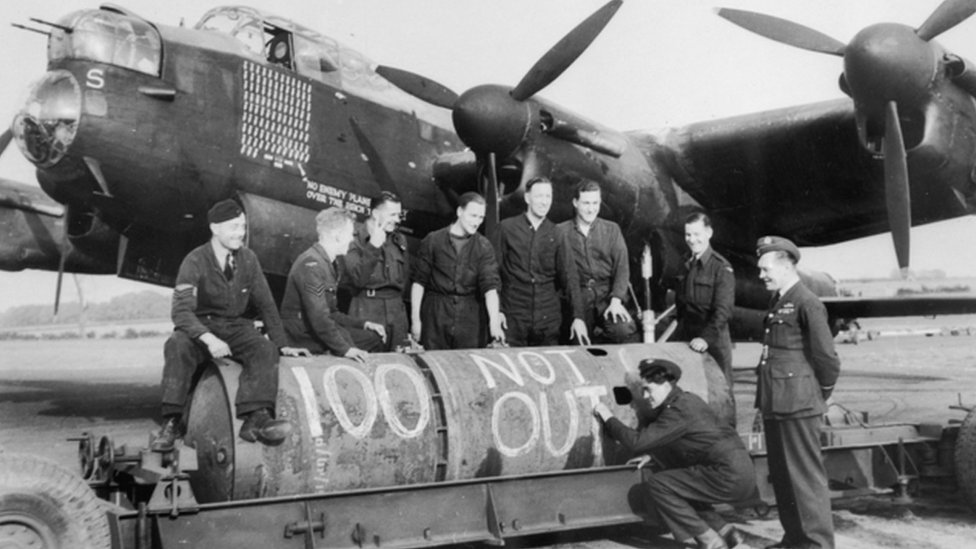

The aircraft had crashed into a field near a small village in the Loire Valley, and a villager later wrote a graphic account of the incident. R Robert crashed in flames having lost the tail section, and with the fire raging ordnance began to explode completely burning out the aircraft. A few miles North West of the target the Squadron was intercepted by the dreaded night fighters and three aircraft were shot down. For some reason they were flying much lower than usual, perhaps to try to avoid enemy radar alerting the night fighters who were stalking the Squadrons and finding the Lancaster’s vulnerable under-belly. The Squadron flew out via Reading crossing the coast at Portland Bill. The trip to the Loire Valley to fulfil their mission, which was in preparation for D-Day, should have been ‘a piece of cake’ according to those who later recalled the events of that evening. The aircraft was skippered by Flying Officer Bartlett, and had survived some punishing trips prior to the final one, in fact they would have been considered ‘old hands’ by newcomers to the Squadron. It was only in recent years, and almost by chance that I learned more about the fate of Brian who was the Flight Engineer, and the crew of R-Robert who set off on the late evening of 7th May 1944 to bomb an ammunition dump near Orleans in France. Occasionally my friend talked to me about Brian because I myself was a Private Pilot with a keen interest in aviation history, particularly the Second World War. Brian D west of 106 Squadron based at Metheringham, Lincolnshire.

I was a close friend of the Fiancee of Sgt. At debriefing, Frank, the mid-upper gunner, said that a string of bombs with a wobbling blockbuster dropped past our starboard tail-plane as our own bombs were leaving. We landed back at Wickenby at 42 minutes after midnight. At last we were through the target and turning south over the Rhine and my stomach muscles started to relax.’ 4,000 feet was reckoned to be the absolute minimum height for dropping a blockbuster. Stan gave, “Right, right, steady, bombs away.” then our aircraft was bucking and rearing as the pressure waves hit us. Large columns of thick black smoke rose from the town up to 3,000 feet.
#Lancaster bomber crew numbers full
A stricken Lancaster crashed on its run-in blowing up with its full bomb load.

Flashes from the exploding blockbusters on the ground were blinding. Strings of bombs were falling through the cloud from the Lancs above. They seemed to be coming from eight different positions and looked like 20 mm and 37 mm, which are nasty blighters at the height we were at. Red and yellow tracer shells were crisscrossing from the flak batteries outside the town. Stan, who could not see the other Lanc, had started his run-up patter giving me “Right,” and shouted agitatedly, “Right, not bloody left!” I jabbed the left rudder to slide clear of it. Then I had to dodge under another Lancaster coming from our port side, looking up into its yawning bomb bay with its rows of 500lb bombs and a cookie. Stan, the bomb aimer, gave “Bomb-doors open”, and we heard the clear, casual voice of the Master Bomber, “Bomb to starboard of the red Target Indicators”. The one hundred and forty or so Lancaster pilots that did obey the Master Bomber converged onto the tight bunch of target markers. Over half the main force did not come below cloud but bombed through it on the fires and flares that could be seen through the thin layer. This turned out to be one hell of a dangerous bombing run. To comply with his orders, I closed the throttles and put the aircraft into a dive, getting under the cloud and levelling off at 4,000 feet. There was a layer of thin cloud at 5,000 feet and we clearly heard the Master Bomber, who was circling in a Mosquito at 3,000 feet, ordering the main force to come below cloud. We took off at 7pm and at 10pm approached the target at 10,000 feet.

This operation was to prepare the way for the attack by 15th Scottish Division across the German frontier near Reischwald. ‘On February 7th 1945 we were briefed for a night raid on Kleve. Then I had to dodge under another Lancaster coming from our port side, looking up into its yawning bomb-bay with its rows of 500lb bombs and a cookie.įlying Officer Roy Yule DFC – a Lancaster pilot and captain on No 626 Squadron based at RAF Wickenby, Lincs during 1945.


 0 kommentar(er)
0 kommentar(er)
